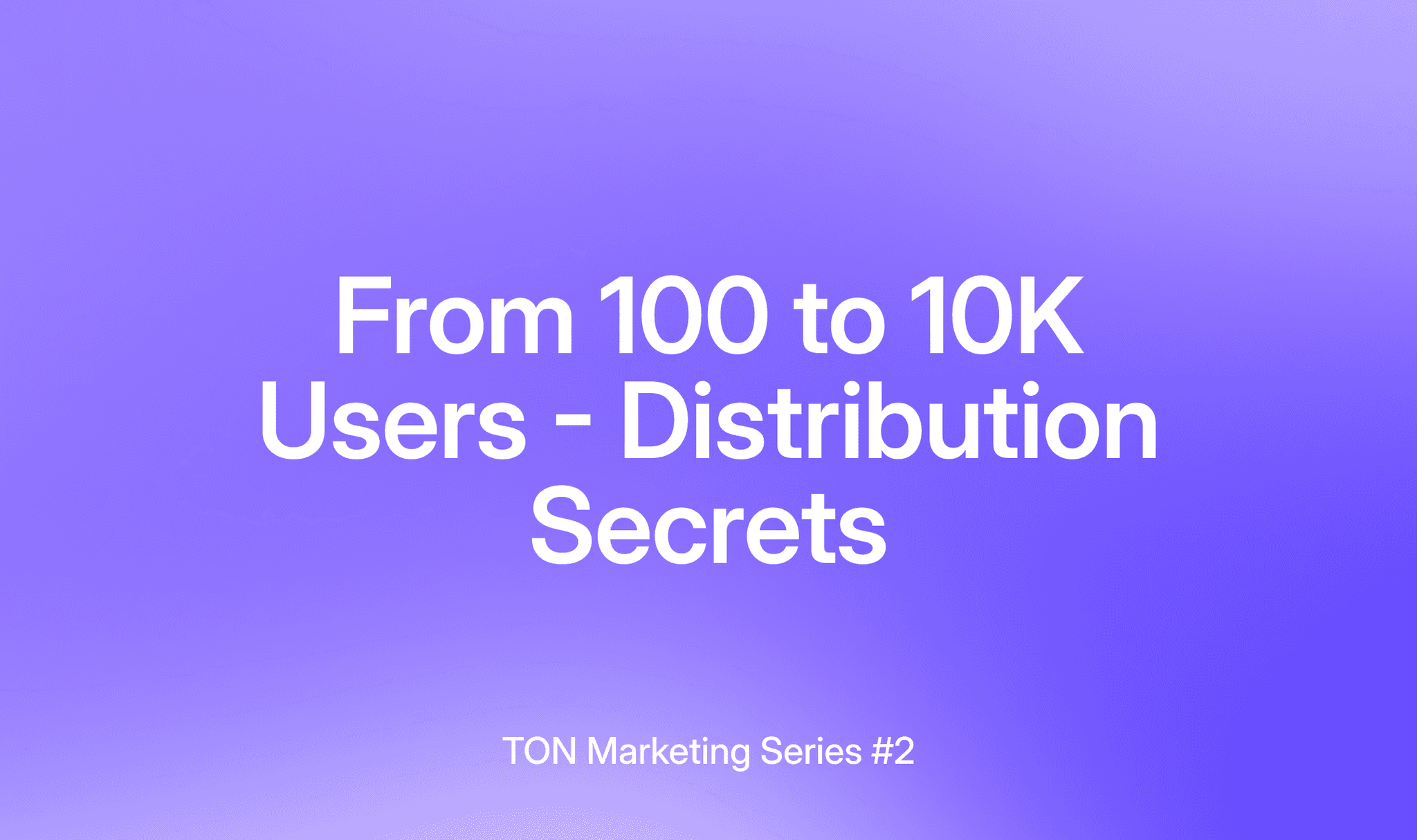Going Viral - KOL Marketing & Paid Ads — TON Marketing Series #3

Amplify what's working through influencers, advertising, and viral mechanics
You've built a solid foundation and identified growth channels that work. Now it's time to amplify successful strategies through influencers, advertising, and viral mechanics. This is Phase 3 of our 4-part TON marketing series, focused on amplification and reach.
KOL Marketing: Authenticity Over Reach
Most teams approach influencer marketing backwards. They chase follower counts instead of audience alignment. In TON's ecosystem, a crypto-native influencer with 10K engaged followers often outperforms a generic lifestyle influencer with 100K.
Finding the Right KOLs
Start with your network: You likely know someone with reach already
TON Talents: Filter by "Marketing" to find KOL agencies and managers
Curated TON KOLs list: Reach out to creators who already work with TON projects
TON Circle: Platform to run paid KOL campaigns with verified TON creators across Telegram, X, and YouTube
KOL Campaign Approach
Start small: Begin with micro-influencers (1K-10K followers) who have high engagement rates and cost less to test messaging.
Focus on fit: Choose influencers whose audiences align with your target users, even if their follower count is lower.
Performance-based when possible: Instead of flat fees, consider offering base fees plus performance bonuses, revenue sharing from referred users, or tiered rewards.
Creative freedom: Give influencers guidelines but let them create content in their own voice. Authentic recommendations perform better than scripted ads.
Remember that influencer marketing takes time to show results and not every collaboration will drive significant users. It's about building awareness and credibility as much as immediate acquisition.
Paid Advertising: Test, Learn, Scale
By this point, you should know which messages work and which audiences convert. Paid advertising lets you amplify these insights.
Telegram-Native Advertising
Channel partnerships: Use TGStat to find relevant channels by category and audience size.
Ad marketplaces: Telega.io, Plarin, and Clicksdealer can help you run campaigns across multiple channels.
Direct outreach: Contact channel owners directly. This often results in better rates and more flexible arrangements.
You can also find agents or ad managers through TON Talents (Marketing category).
Telegram ad networks:
-
Telegram Ads: Official ads shown in public Telegram channels
-
AdsGram: Performance-based ad network for Telegram Mini Apps
-
OpenAD: Offers free ad credits and bonuses for TON-native projects
-
Monetag: Monetization and ad solutions across web and Telegram
Creative testing approach:
-
Text posts with strong hooks
-
Memes related to your niche
-
Short demo videos
-
User testimonials and success stories
Test these formats to see what resonates with your audience before scaling.
Beyond Telegram
Once your Telegram funnel converts well, you can expand to other platforms:
X (Twitter) ads: Target crypto and Telegram users with keyword and interest targeting
Meta ads: Great for visual products; use Stories and Reels
TikTok ads: Perfect for gamified apps with demo potential
YouTube: Sponsor creators to demo your app and walk through use cases
Programmatic ads: Use platforms like Google Ads if your product includes a web landing or onboarding flow outside Telegram.
Scaling approach: Start with small daily budgets, measure true unit economics (lifetime value vs acquisition cost), and scale only channels that show positive return on investment.
Viral Marketing: Engineering Shareability
Virality isn't random luck. It's about creating mechanics that make sharing beneficial and easy for users.
Telegram Stories: Your Unique Advantage
Unlike other social networks, Telegram Stories is the only way users can reach their contacts directly. When designed well, this creates powerful growth loops.
Case Study: Banana Meter users challenged friends based on banana sizes. This simple mechanic led to hundreds of thousands of Story shares and a K-Factor of 3.95 (nearly 4 new users per user).
Why it worked:
-
Tapped into universal humor and competitive elements
-
Results were visual and shareable
-
Simple to understand and participate in
Building for Stories: Create shareable moments within your app, make results visual and interesting, add competitive or comparison elements, and include clear calls-to-action for friends.
Referral Systems: The Compound Effect
Case Study: @UpscaleTradeBot
This prop trading mini app reached 70,000 monthly active users with 99% coming from referrals through performance-based rewards and progressive incentives.
Referral mechanics that can work:
-
Mutual benefits (both parties get rewards)
-
Progressive rewards (more referrals = better rewards)
-
Time-limited bonuses to create urgency
-
Leaderboard competitions
If you monetize through Telegram Stars, consider leveraging the Telegram Affiliate Program for additional growth incentives.
Competition and Leaderboards
Case Study: @egg_fight_demo_bot
A simple rock-paper-scissors game with winner-takes-all leaderboard reached 1.2M monthly active users through pure competition and shareable progress updates.
Competition design principles:
-
Clear, simple rules that anyone can understand
-
Regular reset periods (daily/weekly/monthly)
-
Multiple ways to participate and win
-
Social proof through visible leaderboards
-
Shareable achievements and milestones
Narrative-Driven Growth
Case Study: Notcoin
Became a global phenomenon by embracing ambiguity with its "probably nothing" campaign. The teasing, playful narrative became instantly memeable and fueled massive curiosity.
Case Study: Cluely
Backed by a16z, Cluely is an AI startup that grew rapidly through bold, attention-grabbing content and "cheat-on-everything" positioning. (Viral tweet example | Article)
Creating shareable narratives:
-
Take a clear, potentially memorable position
-
Make it instantly understandable
-
Stay consistent across all communications
-
Create content that people want to share
Reality check: Viral growth is unpredictable. These mechanics can help, but they're not guaranteed to work for every product. Focus on building great experiences first.
Geographic Expansion: Think Local
Different regions have different user behaviors, platform preferences, and marketing channels. What works in the US might not work in Southeast Asia.
Regional Strategy
TON Hubs are your fastest path to understanding regional nuances:
-
Connect with local builder communities
-
Access regional KOL networks
-
Get cultural insights and messaging guidance
-
Understand regulatory considerations
Market entry process:
-
Research: Connect with your relevant Hub, study local successful projects
-
Test: Small campaigns with local partners or KOLs
-
Scale: Full marketing approach adapted for the region
-
Optimize: Refine based on local data and feedback
Learn from TON-native teams in your target region: Identify mature projects already active in your desired geography through TON Nest or TON Fam.
Work with local experts: Browse TON Talents and filter by Marketing to find regional specialists who understand both the local market and TON ecosystem.
Remember: Going local doesn't mean just translating content. It means adapting your messaging, channels, and growth tactics to match how users in that region discover, trust, and adopt products.
Scale Phase Success Signals
-
KOL campaigns are driving measurable user acquisition
-
Paid advertising channels show positive ROI
-
Viral mechanics are creating organic growth loops
-
Geographic expansion is opening new user segments
What's Next?
Once you've reached significant scale, you'll be ready for Phase 4: Optimization through analytics, media relations, and sustainable growth systems. In our final article, we'll cover advanced analytics, PR strategy, and working with agencies to build long-term success.
The scale phase is about amplification, but don't lose sight of unit economics and sustainable growth. Not every channel that drives users will be profitable in the long term.
This is Part 3 of our 4-part TON Marketing Series. For more ecosystem support and resources, visit https://builders.ton.org.

